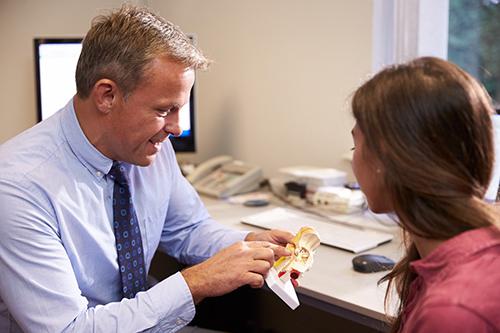Hearing Loss Symptoms Explained
Hearing loss is more and more common condition, people of all ages experience it. In some cases, your symptoms can explain what form of hearing loss you experience. The two most common forms of hearing loss is Tinnitus and Hyperacusis.
explain what form of hearing loss you experience. The two most common forms of hearing loss is Tinnitus and Hyperacusis.
Tinnitus is the perception of sound when no actual external noise is present. While it is commonly referred to as “ringing in the ears,” tinnitus can manifest many different perceptions of sound, including buzzing, hissing, whistling, swooshing, and clicking. In some rare cases, tinnitus patients report hearing music. Tinnitus can be both an acute (temporary) condition or a chronic (ongoing) health malady.
Tinnitus
Millions of Americans experience tinnitus, often to a debilitating degree, making it one of the most common health conditions in the country. The U.S. Centers for Disease Control estimates that nearly 15% of the general public — over 50 million Americans — experience some form of tinnitus. Roughly 20 million people struggle with burdensome chronic tinnitus, while 2 million have extreme and debilitating cases.
Hyperacusis
Hyperacusis is the generic term used to describe hypersensitivity to sounds, especially to high-pitched sounds, typically in the presence of normal hearing. Hyperacusis can also be named as a sound intolerance problem. It often appears following a traumatic sound exposure or accompanies a tinnitus.
There are subcategories of hypersensitivity to sounds including: Misophonia or selective hypersensitivity to certain sounds which is characterized by an intense reaction to very specific weak sounds, which are generally physiological sounds (eg, sounds of chewing, breathing, etc.) and which generally appear during childhood, between the ages of eight to twelve.
If you believe you may be experiencing hearing loss from either of these conditions, please call our offices at your earliest convenience.
Fact: Tinnitus be a debilitating condition, that negatively affects a patient’s overall health and social well-being. Even moderate cases can interfere with the ability to work and socialize. As many as 63 percent of tinnitus patients also suffer from hyperacusis
Fact: Hyperacusis is a rare hearing disorder that causes sounds which would otherwise seem normal to most people to sound unbearably loud. People who suffer from hyperacusis may even find normal environmental sounds to be too loud such as traffic noise, music or being in a restaurant.
Don't needlessly suffer with Tinnitus or Hyperacusis. We can help!
Tinnitus Treatment
While there is no known cure for most forms of tinnitus, there are many management options available and most tinnitus sufferers can find varying degrees of relief of your hearing loss from one or a combination of the following.
- Medication: There is no single medication that works on all tinnitus patients. Some of the antidepressants and anti-anxiety medications available are helpful for certain tinnitus patients, however more research is needed in this area.
-
Music Therapy: Many patients find that music, particularly classical passages that don't contain wide variations in loudness (ampliltude) can be both soothing to the limbic system (the emotional processor in the brain that is commonly negatively linked to a patient's reaction to tinnitus) and stimulating to the auditory cortex. If a hearing loss is present, it may be necessary to alter the spectrum of the music so that the cortical neurons.
-
Acoustic Therapy: Acoustic (sound) therapy” is a broad term that may be used in many ways, depending on the specific product, clinical setting, or individual clinician. In general, sound therapy means the use of external noise in order to alter a patient’s perception of, or reaction to, tinnitus. Like other tinnitus treatments, sound therapies do not cure the condition, but they may significantly lower the perceived burden and intensity of tinnitus.
-
Auditory Habituation/Tinnitus Retraining: These techniques consist of two main components — directive counseling and low level sound generators. Direct counseling provides intensive, individualized education regarding the causes and effects of tinnitus on the ear, the brain, and the coping mechanism. Low level sound generators produce broadband noise via hearing aid type devices at a soft enough level so that the brain perceives both the noise and the tinnitus. Eventually, the brain may relearn a pattern that will de-emphasize the importance of the tinnitus. These devices also may be helpful in desensitizing patients who are overly sensitive to sound.
Hyperacusis Treatment
Although a corrective surgical or medical approach for treating hyperacusis is not available at this time, there are a number of existing therapies that can help reduce a person's fears and anxieties about the disease, as well as their actual sensitivity to sounds. These may include retraining and acoustic therapies.
- Retraining Therapy: Retraining therapy consists of counseling and acoustic therapy. The aim is to reduce a patient's reactions to hyperacusis. Counseling is designed to help a patient better cope with their hearing loss, while acoustic therapy is used to decrease a patient's sensitivity to sounds and to teach them to view sound in a positive manner.
-
Sound Generators: This treatment approach uses the sound of music or noise produced via a body-worn system or a small device that looks like a hearing aid, which produces steady, gentle sounds. The theory is that by listening to a sound at a low level for a certain amount of time each day, the auditory nerves and brain centers will become desensitized and able to tolerate normal environmental sounds again. In most cases, the treatment is successful, but takes anywhere from three months to two years for improvements to be made.
